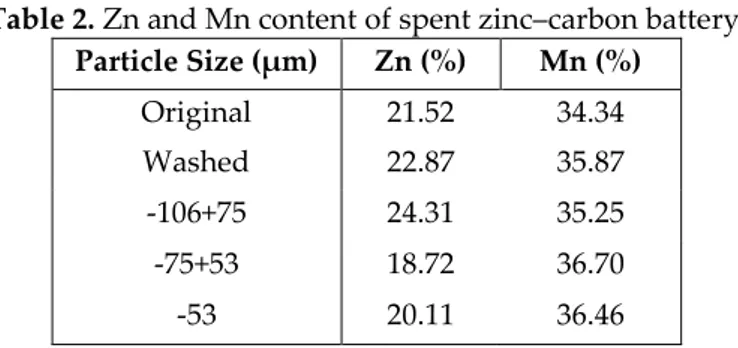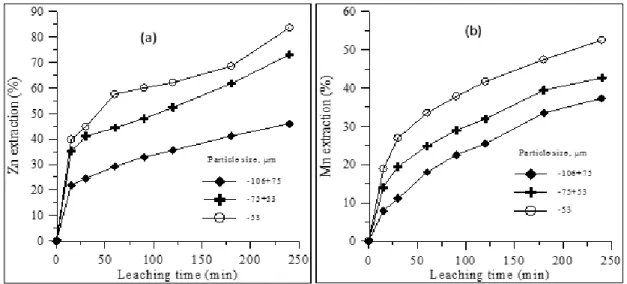LEACHING OF ZINC AND MANGANESE FROM SPENT ZINC–CARBON BATTERIES IN ACETIC ACID SOLUTION
1Hasan Ali TANER, 2Tevfik AGACAYAK, 3Ali ARAS
1,2,3Selcuk University, Department of Mining Engineering, Campus, Selcuklu, Konya, TURKEY 1hasanalitaner@selcuk.edu.tr
,
2tevfik@selcuk.edu.tr, 3aliaras@selcuk.edu.tr(Geliş/Received: 01.06.2016; Kabul/Accepted in Revised Form: 10.07.2016)
ABSTRACT: In this study, extraction of Zn and Mn from spent zinc–carbon batteries in acetic acid solution was studied. Leaching tests were carried out to evaluate the leaching behaviour of Zn and Mn under different conditions. Experimental parameters used were; stirring speed, acetic acid concentration, temperature and particle size. The zinc and manganese extraction were obtained as 83.59% and 52.47%, respectively. The maximum Zn and Mn extraction were obtained in 240 min of leaching time with the following conditions; 600 rpm stirring speed, 2.0 M acetic acid concentration, -53 µm particle size and 60°C leaching temperature.
Key Words: Leaching, Zn–C batteries, Zinc, Manganese, Acetic acid.
Asetik Asit Çözeltisinde Atık Çinko–Karbon Pillerinden Mangan ve Çinkonun Liçi
ÖZ: Bu çalışmada, asetik asit içerisinde atık çinko–karbon pillerinden Zn ve Mn’nin ekstraksiyonu çalışılmıştır. Farklı koşullar altında Zn ve Mn çözünme davranışlarını araştırmak için liç testleri yapılmıştır. Deneylerde kullanılan parametreler; karıştırma hızı, asetik asit derişimi, sıcaklık ve tane boyutudur. Çinko ve manganın çözünme verimi sırasıyla %83.59 ve %52.47 olarak bulunmuştur. 600 dev/dk karıştırma hızında, 2 M asetik asit derişiminde, -53 µm tane boyutunda, 60°C liç sıcaklığında ve 240 dakikalık liç süresinde en yüksek Zn ve Mn çözünme verimi elde edilmiştir.
Anahtar Kelimeler: Liç, Zn–C piller, Çinko, Mangan, Asetik Asit INTRODUCTION
Zinc–carbon and alkaline batteries are non–rechargeable batteries and they are discarded after being used up (Rayovac, 1999). Spent batteries cause environmental and health problems (Kierkegaard, 2007). Besides, battery residues are valuable because of containing zinc, manganese and other metals (Bartolozzi, 1990). Therefore, recycling of spent batteries is important for stringent environmental regulations.
Recycling the metals from spent batteries is a growing challenge because portable devices that require such electrical power source play an increasing role in modern life. Only in the European Union more than 230,000 tons of portable batteries are put on the market yearly but only about 30% per year of spent batteries recycled in Europe. In European Union, Belgium collects about 50% of the spent batteries it uses (EPBA, 2013).
Most of countries have already reached the 25% collection target for 2012 in European Union. A total of 25,529 and 26,660 tonnes of alkaline, zinc–carbon and zinc–air batteries were recycled in 2011 and 2012, respectively, by European Battery Recycling Association (EBRA) members (EBRA, 2012).
The spent Zn–C batteries contain zinc, manganese dioxide and also zinc oxide and manganese (III) oxide produced from discharging reaction (Bernardes et al., 2004; Park et al., 2006; Shin et al., 2009). They are important secondary source of zinc and manganese. A lot of studies were found related with leaching of spent Zn–C battery in the literature (Ferella et al., 2008; Shin et al., 2009; Baba et al., 2009; Sayilgan, 2010; Gęga and Walkowiak, 2011; Kursunoglu and Kaya, 2014; Buzatu et al., 2014). Generally, these studies were carried out using only basic solution, acidic solution (hydrochloric acid, sulphuric acid) or reductive agents with this acid solutions.
In this study, extraction of Zn and Mn from spent zinc–carbon batteries using only acetic acid solution which is environmentally safe and low cost compared to other reactants used in literature was studied. The purpose of the present work is to maximize the extraction yield of both zinc and manganese using acetic acid solution. In addition, it was aimed to determine effect of leaching parameters to extraction of Zn and Mn from spent Zn–C battery powder.
EXPERIMENTAL Sample Preparation
Spent zinc–carbon batteries were collected from Selcuk University battery collection boxes in Turkey. The batteries were manually dismantled. Dismantling products such as plastic films, paper pieces, carbon rod, black paste and metallic materials were separated. The separated products were weighed and mass of each component were given in Table 1. Moisture of black paste was 12.51%, calculated by weight difference after drying at 105°C for 24 hour.
Table 1. The weight percentage of spent zinc–carbon battery.
Components %
Metal cover and bottom 2.53
Plastic 3.33 Paper 4.65 Carbon rod 7.65 Zinc can 11.58 Steel can 13.84 Black paste 56.42
The battery powder was ground using a ball mill and sieved to obtain particle size less than 106 µm. The powder was washed with distilled water in a glass vessel at 60°C. The aim of this washing was the removal of electrolyte in Zn–C batteries. After this process, drying was applied to the powder at 105°C for 24 hour and then the powder was burned for one hour at 600°C in furnace. Sieving was carried out and -106+75, -75+53, -53 µm particle size fractions were produced. Original and washed zinc–manganese content of the powder were given in Table 2.
Table 2. Zn and Mn content of spent zinc–carbon battery. Particle Size (µm) Zn (%) Mn (%) Original 21.52 34.34 Washed 22.87 35.87 -106+75 24.31 35.25 -75+53 18.72 36.70 -53 20.11 36.46 Leaching Procedure
In the leaching process, the powder was fed into a 1000 mL glass vessel including acetic acid solution. A Teflon coated mechanical stirrer and thermostatically controlled water bath were used. The leaching parameters chosen were 200–600 rpm stirring speed, 30–70°C temperature, 1–4 M acetic acid concentration and -106+75, -75+53, -53 µm particle size. One gram of battery powder was used in all experiments. Zinc and manganese ions in the solution were determined using flame atomic absorption spectrophotometer (GBC mark AAS). Distilled water and reagent grade CH3COOH (Merck) were used to prepare the leaching solutions.
RESULT AND DISCUSSION
A series of laboratory leaching tests were conducted to define the efficiency of Zn and Mn extraction. Effect of leaching parameters including stirring speed, CH3COOH concentration, temperature and particle size on the Zn and Mn extraction from zinc–carbon battery powder was studied.
Effect of stirring speed
The effect of stirring speed in the range of 200–600 rpm on the Zn and Mn extraction from the powder of -75+53 µm particle size was investigated in 1.0 M CH3COOH solution at 60°C. The results presented in Fig. 1 a–b show that the extraction of zinc and manganese are dependent to stirring speed, that is, extraction recoveries increase with increasing stirring speed. Therefore, 600 rpm was selected as optimum operating stirring speed to determine the other parameters.
Effect of Acetic Acid Concentration
The effect of acetic acid concentration on the extraction of zinc and manganese was investigated in 1.0 to 4.0 M CH3COOH solution at stirring speed experiments’ conditions. The results given in Figure 2 show that extraction of zinc and manganese are dependent to acetic acid concentration, that is, extraction recoveries increase with increasing acetic acid up to 2.0 M. No clear increase in extraction recoveries was observed at 2.0–4.0 M. Hence 2.0 M was selected as acetic acid concentration for subsequent experiments.
Figure 2. Effect of acetic acid concentration on the recovery of zinc (a) and manganese (b). Effect of Temperature
The effect of temperature on the extraction of zinc and manganese was investigated in 2.0 M CH3COOH solution using 600 rpm stirring speed. The results obtained are given in Figure 3. The extraction recoveries increase with increasing temperature up to 60°C. At temperature above 60°C a decrease was observed in Zn and Mn extraction. It may be caused because of vaporization of CH3COOH at higher temperatures. Hence 60°C temperature was selected for subsequent experiments.
Effect of Particle Size
The experiments were carried out with three different particle sizes (-106+75, -75+53 and -53 µm) in 2.0 M CH3COOH solution at 60°C. The results are shown in Fig. 4. As shown in Fig. 4, the Zn and Mn dissolution percentage increases with decreasing particle size. Zn and Mn extraction percentage reached to 83.59% and 52.47% after 240 minutes of leaching for -53 µm particle size, respectively.
The reason of the higher dissolution percentage of the finer size fraction is due to the higher specific surface area of the ground sample. The higher the specific surface area of the powder is the higher the Zn and Mn extraction.
Figure 4. Effect of particle size on the recovery of zinc (a) and manganese (b). CONCLUSION
This paper presents leaching of Zn and Mn with acetic acid from spent Zn–C batteries. The following conclusions can be drawn from this study: extraction recoveries of zinc and manganese increase with increasing stirring speed and acetic acid concentration up to 2.0 M. The extraction recoveries increase with increasing temperature up to 60°C. Above 60°C a decrease was observed in zinc and manganese extraction because of vaporization of CH3COOH at higher temperatures. Zinc and manganese dissolution percentage increases with decreasing particle size, because of increase in surface area. As a result of this study, the appropriate extraction condition was obtained with 600 rpm stirring speed, 2.0 M CH3COOH solution, 60°C temperature and -53 µm particle size. With this condition, 83.59% and 52.47% dissolution recoveries were achieved after 240 minutes of leaching for zinc and manganese, respectively.
REFERENCES
Baba, A.A., Adekola, A.F., Bale, R.B., 2009, “Development of a combined pyro– and hydro–metallurgical route to treat spent zinc–carbon batteries”, Journal of Hazardous Mat., Vol. 171, pp. 838–844. Bartolozzi, M., 1990, “The recovery of metals from spent alkaline–manganese batteries: a review of
patent literature”, Resources, Conservation and Recycling, Vol. 4, pp. 233–240.
Bernardes, A.M., Espinosa, D.C.R., Tenorio, J.A.S., 2004, “Recycling of batteries: a review of current processes and technologies”, Journal of Power Sources, Vol. 130, pp. 291–298.
Buzatu, M., Saceanu, S., Petrescu, M.I., Ghica, G.V., Buzatu, T., 2014, “Recovery of zinc and manganese from spent batteries by reductive leaching in acidic media”, Journal of Power Sources, Vol. 247, pp. 612–617.
EBRA, 2012, “European Battery Recycling Association”, http://www.ebrarecycling.org, visit date: May 10, 2016.
EPBA, 2013, www.epbaeurope.net (European Portable Battery Association), visit date: May 10, 2016. Ferella, F., De Michelis, I., Veglio, F., 2008, “Process for the recycling of alkaline and zinc–carbon spent
batteries”, Journal of Power Sources, Vol. 183, pp. 805–811.
Gęga, J., Walkowiak, W., 2011, “Leaching of zinc and manganese from used up zinc–carbon batteries using aqueous sulfuric acid solutions”, Physicochem. Probl. Miner. Process., Vol. 46, pp.155– 162.
Kierkegaard, S., 2007, “EU battery directive, charging up the batteries: squeezing more capacity and power into the new EU battery directive”, Computer Law & Security Report, Vol. 23, pp. 357– 364.
Kursunoglu, S., Kaya, M., 2014, “Dissolution and precipitation of zinc and manganese obtained from spent zinc–carbon and alkaline battery powder”, Physicochem. Prob. Miner. Process., Vol. 50(1), pp. 41-55.
Park, J.T., Kang, J.G., Sohn, J.S., Yang, D.H., Shin, S.M., 2006, “Physical treatment for recycling commercialization of spent household batteries”, J. Korean Inst. Resour. Recycl., Vol. 15 (6), pp. 48–55.
Rayovac, C., 1999, “Material safety data sheet”, Available from http://rayovac.com.
Sayilgan, E., 2010, “Acidic leaching and precipitation of zinc and manganese from spent battery powders using various reluctants”, Journal of Hazardous Materials, Vol. 173, pp. 137–143.
Shin, M. S., Senanayake, G., Sohn, J., Kang, J., Yang, D., Kim, T., 2009, “Separation of zinc from spent zinc–carbon batteries by selective leaching with sodium hydroxide”, Hydrometallurgy, Vol. 96, pp. 349–353.


